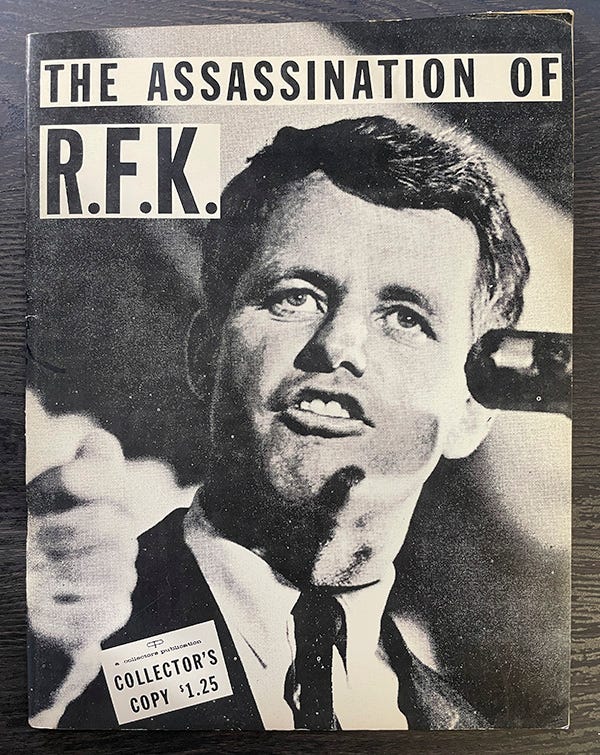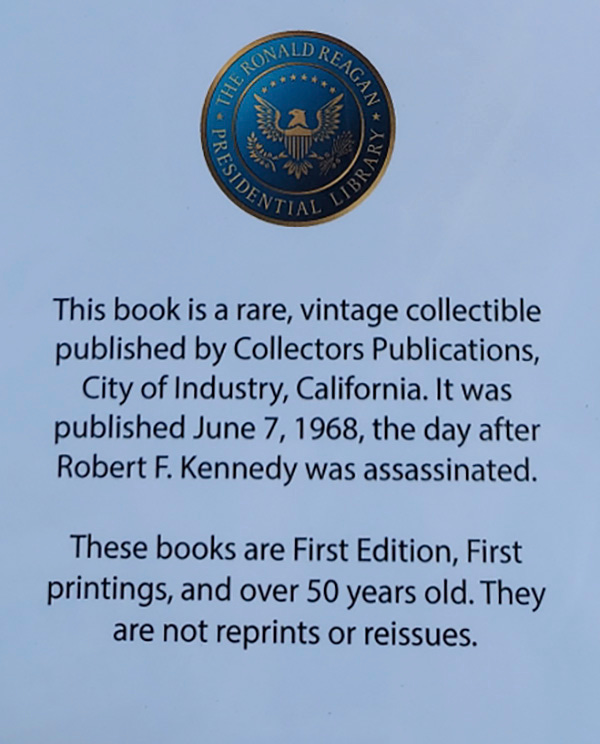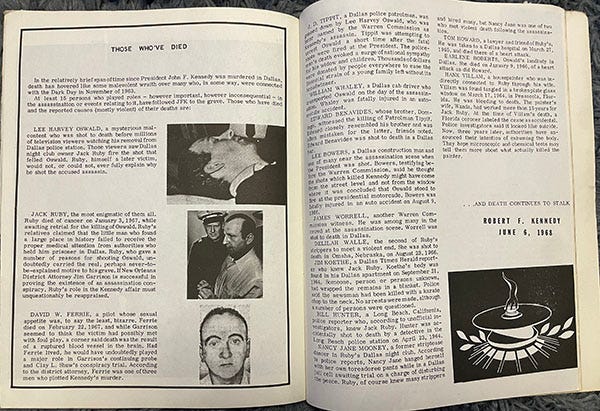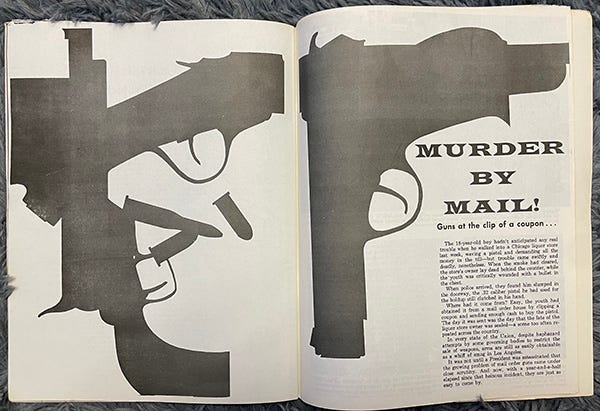I Went to the Reagan Library and All I Got Was a Souvenir Program From the Bobby Kennedy Assassination
It was the only thing in the gift shop without Reagan's name on it
Ronald Reagan is the worst American president of all-time. At (pronounced “@”) me if you want to, I am more than ready to defend that position. It’s a thing I’ve talked about a whole bunch in my writing and podcasts both.
So it might come as a bit of a surprise that I recently made a trip to the Reagan Library in Simi Valley, California.
The thing is, that place is also a museum, and sometimes they have cool exhibits. I was there to see one about the history of the FBI. Not that I love the FBI any more than I love Reagan, but I sure do love crime! Have you seen the car Bonnie and Clyde died in up close? Don’t judge me until you have.
I tragically lost a bunch of pictures I took of the FBI exhibit, but I did manage to keep the one of this genuinely hilarious plaque that’s all about how the FBI has always been committed to upholding civil rights.
That’s cute. Also, civil rights make a good segue into the real point of this article, which is the thing I found in the gift shop at the Reagan Library.
I’m not ashamed to admit that I am an absolute sucker for a gift shop purchase. If I pay to get into a place and that place has a gift shop, I’m probably buying something at that gift shop. How else am I supposed to prove to people that I’ve actually been to that place? Anyone can download a picture of the Space Needle from the internet and pass it off as evidence that they’ve seen it, but only us trues own the trucker hat that undeniably proves it.
So, despite my absolute disdain for Ronald Reagan and the FBI both, upon ending my visit to the Reagan Library, I was determined to find myself a memento to take home with me. I had but one simple rule…nothing with Ronald Reagan’s name on it. That is absolutely a bridge too far.
I assumed that would severely limit my purchasing options, but I had no idea how severe those limitations would be. I thought I’d gotten lucky with an ironically cool Air Force One hat, only to turn it around and find that it said “Reagan Bush ‘84” on the back.
So that left me two options, with one of those options just being a regular-ass bag of Jelly Belly jelly beans that gave absolutely no indication they were from the library of a dementia-riddled fascist war criminal.

I can get that at Walgreen’s, and I damn well might when I’m done writing this article. Those are the only truly great jelly beans. I guarantee it’s the only thing me and Reagan would’ve agreed on.
So, that left me with just one other choice if I was hoping to take home a trinket to remind me of the time I paid money to visit a shrine to the guy who sent my dad’s printing press job to Mexico. This…
I know we all have a lot of questions. I certainly did. The first being…”Is that real?” It sure is! It came with a certificate of authenticity and everything!
So rest easy knowing I wasn’t swindled into buying counterfeit…assassination memorabilia?
Don’t get me wrong, I guess I get why a collectible like this would exist. Why it was literally the only Democrat-related thing in the entire gift shop at the same time an FBI exhibit was occupying the museum wing of the building is beyond me, though, if it’s not just straight up trolling.
I mentioned in my previous article about fascism in America that the 1960s were the point in history when progressives were getting assassinated at an alarming rate in this country, but definitely not by the same recently-Nazi-infused-FBI that was firing off letters to MLK suggesting he should commit suicide. They would never!
If we’re talking the big household names in American political assassinations, the deaths of JFK and RFK bookend that period. Way more than a memorial to RFK, this book I bought at the Reagan Library when the FBI was in town reads like a commemoration of that period in history. A period that a fascist government like ours might secretly view as highly successful.
I already touched on it in the caption under the last image, but one of the first bits of weirdness about this book is when it came out. This thing was on store shelves the day after Robert Kennedy died. For being a 24-hour rush job, this RFK assassination souvenir is highly detailed. So much so that…I don’t know…it feels like a lot of it might have been written before the fact?
It kicks off with an interview with the hotel worker who held Kennedy’s head after he was shot, and then follows that up with a shockingly graphic picture of said hotel worker holding said head, paired with President Lyndon Johnson’s message to the American people in the wake of the shooting.
I will say this, the people behind this book were obviously motivated to get the “official” story of what happened out to the public as soon as possible, and they sure had access to a lot of crime scene photos and witness interviews to make that happen.
That includes some very sharp photos of the man who was definitely the only shooter in the room.
If it seems like I’m being sarcastic about the “only shooter in the room” thing, it’s because I am! Here, check out the next section of the book.
Again, already knowing bullet entry areas with enough confidence to publish them in a “collector’s edition” program the day after the assassination isn’t NOT weird. Right? Am I overthinking that? I don’t think I am.
That said, the really interesting part of this section is what it implies about the bullet that killed RFK. It was the one that went in behind his right ear, as seen in the picture. But that picture makes it seem like that shot was fired from a distance. It wasn’t. He was shot at point blank range behind the ear.
That presents a huge problem in that, by all witness accounts, Sirhan Sirhan never got close enough to Bobby Kennedy to shoot him at point blank range. That’s why, if you dig into it, you’ll find source upon source upon source throughout the years questioning if there was maybe a second shooter in the room. Whether intentional or not, the publishers of this book went a long way toward cutting off that version of events at the pass.
Hey, let’s talk about the publisher for a bit! It was a company called Collector’s Publication that was seemingly run by a man named Walter E. Hurst. One of the first things you see in the book is a message from him, and it’s a weird one.
Cool how it ends by talking about how Robert Kennedy has “done his part” to “make America greater,” huh? That’s not eerie at all! Was “his part” getting murdered by the government? Is that what helped make America greater? I bet there are lots of right wing monsters who would answer in the affirmative, then and now both.
Whatever the case, seeing as how they turned around this detailed accounting of the RFK assassination in such short order, you’d think that Walter E. Hurst and the people at Collector’s Publication cranked out a whole bunch of other similar documents about important people or historical moments.
Well, if they did, I cannot find them. Hurst’s author page on Amazon and Bookfinder.com both make it seem like he published this one keepsake about the other Kennedy assassination and then returned to a life writing about copyright laws and movies that are in the public domain.
The only other thing I found of interest about Hurst and Collector’s Publication is that, about a year before publishing what I still maintain reads like a celebration of the American government’s assassination years, he and his company were sued by another publisher for copyright infringement.
I’m not here to imply that Hurst and Collector’s Publication might have been a shady bunch, but the crux of the lawsuit is that after another publisher went to the trouble of producing an updated version of a book that was in the public domain using all of the fancy techniques that go into that kind of thing, Hurst and Collector’s Publication decided they were just gonna photocopy that version and sell it as their own.
So, hopefully you’ll forgive me for being a little skeptical when it comes to the motivation behind the publishing of this book. Now let’s get back to the book itself.
After a few more pages of sometimes shockingly graphic photos of the assassination scene…
…the book moves into an extended section that covers “The Kennedy Clan.”
Look, maybe it seems like I’m reaching thus far when I say that it feels like there might be some kind of ill-intent behind the publication of this unspeakably macabre souvenir. I can understand why you would feel that way, but also, you haven’t made it to the end of the book already like I have. Let’s go there!
That “Kennedy Clan” section seems like a mostly normal rundown of the family’s history, but the publishers would be remiss if they didn’t toss in a section about how the first Kennedy assassination happened exactly as the government says it happened.
I guess that’s to be expected? But there’s also this page that seems to be an uncredited newspaper article from some point in the past that’s all about Jackie Kennedy setting up a permanent memorial to her dead husband.
Except there’s this one weird, out of nowhere paragraph about how on the same day they were consecrating that memorial, a bunch of no-good-niks were in New Orleans asking a bunch of questions about what really happened to JFK.
It’s as if they’re implying that asking those questions is somehow tantamount to disturbing the dead. Or maybe they’re just commenting on a coincidence. Either way, the inclusion of that paragraph in the book is weird.
Also weird — this article about how more than a dozen people who were connected to the JFK assassination in some way had all died under mysterious circumstances in the few short years since it happened.
Are you familiar with that weird twist in the JFK assassination investigation? It is very true that a whole lot of people, especially those close to Jack Ruby, met unexpected and often violent deaths in the years immediately after the president was killed. I don’t have time to go into all of them here, but I will share the weirdest of the bunch with you.
The section ends with this reminder that the death train eventually rolled into Bobby Kennedy’s station, too.
This entire section feels like a hiding in plain sight kind of thing. At first glance, it reads like this book is just asking questions about a suspicious death. But is it really doing that? Or is this section supposed to act as a reminder of what happens when people get too chatty in a situation like this?
It’s followed up with a few words about how Dr. Martin Luther King Jr had been murdered recently also.
For some reason, that part is shoehorned into this section that, up to this point, has been all about how someone but definitely not the government just loves killing Kennedys.
Then that section ends with what does not AT ALL look like a veiled threat.
Go ahead, tell me I’m overreacting. Tell me that “ONE SON IS LEFT” page doesn’t look like a wanted poster. Tell me I’m just being paranoid about the intentions of the shadowy outfit who published this book.
Then, when you’re done with all that, tell me why for the love of Camelot does the book end with this?
It’s an article about how Lee Harvey Oswald bought the gun he killed JFK with through the mail. Seems a little irresponsible to me, if nothing else.
I know the history buffs out there will mention that the practice of buying guns via mail was outlawed in 1968 with the passage of the Gun Control Act.
Correct! But that was in October, 1968. This book was published in June, 1968. That means any budding Kennedy shooter who might have been inspired by a combination of that “ONE SON IS LEFT” page and this paragraph from the mail-order guns article…
…had a good three to four months to act on that desire. It never happened, probably due in large part to Ted Kennedy driving his own presidential ambitions (and a woman who died) off a dock at Chappaquiddick a little more than a year later. But still, it feels like Ted Kennedy might have dodged a literal bullet here.
Of course, you could always make the argument that a gun control article makes for a perfectly logical ending to a book about the death of Bobby Kennedy. He did die by gun violence, after all.
However, with this being published at a time when we were toying with mind control and state sanctioned assassination both via programs like MK-ULTRA, something about ending this souvenir collectible about the wave of assassinations of progressives in the ‘60s by identifying one more specific target and telling would-be assassins that the clock is ticking on getting guns the easy way makes me feel like this book was never really about memorializing RFK.


























